If you want to know about the types of lamps or cinemas design or principles of design, please click the link.
Heat transfer in buildings refers to the movement of thermal energy from one area to another, within or through a building. This process is important for maintaining comfortable indoor temperatures and for controlling energy usage in buildings.
1) Fundamentals of Heat Transfer
i) Heat Transfer
- Heat can be transferred from one object/ Surface/ Space to another by three modes of heat transfer.
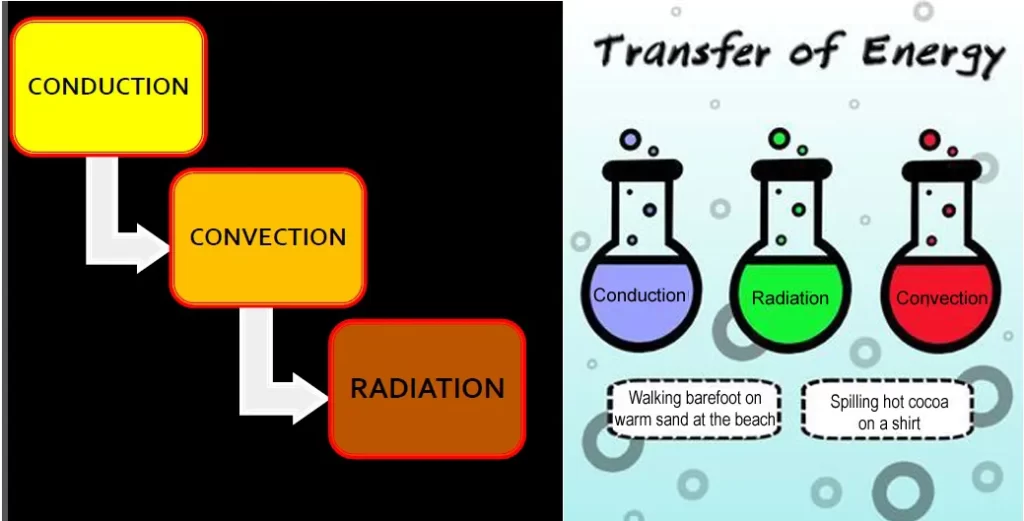
ii) Identify the heat transfer process

- Conduction is the process of transfer of heat in a solid or a fluid at rest by direct molecular interaction between adjacent molecules.
- Convection is the process of heat transfer by flowing and mixing motions in fluids. It is primarily dependent on temperature difference. Natural convection occurs when molecules of cool air absorb heat from a warm surface, rise and carry it away.
- Radiation is the energy that is radiated or transmitted in the form of rays or waves or particles.
What has all this got to do with buildings ???
Well.. Building also lose and gain heat through these three fundamental heat transfer methods.
2) Building Heat Transfer
Heat Transfer
- During day-time, what will be the direction of the heat flow in the building?

- Because outside temperatures tend to be higher than inside. So, heat flows from higher temperature to lower.
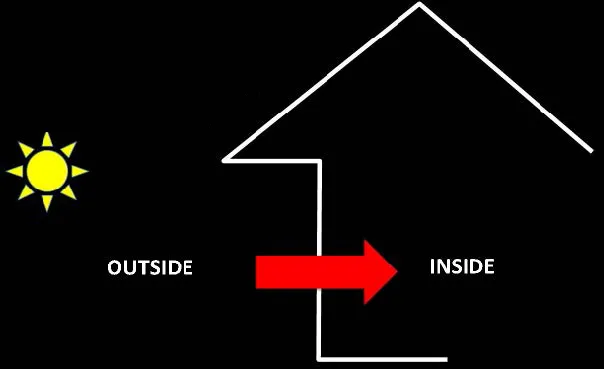
- During night-time, what will be the direction of the heat flow in the building?
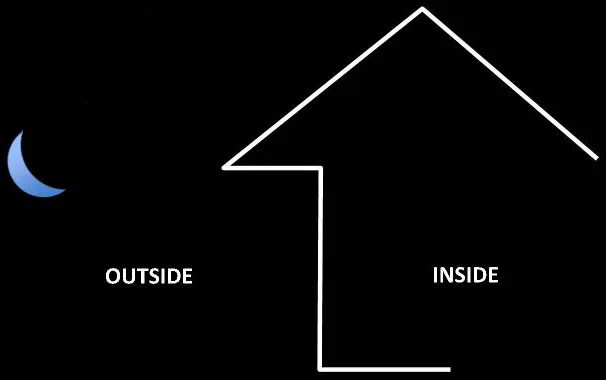
- Heat flows from relatively warm interiors to the cooler exterior.

- Building interiors are required to be kept at certain temperature and humidity level for occupant thermal comfort.
- Thus, the rate of heat transfer has to be controlled / minimized.
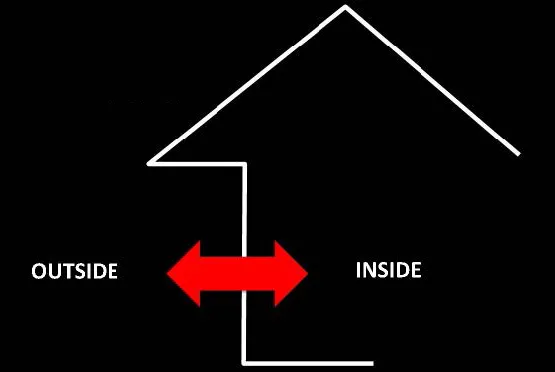
- Thus, a thermal barrier is required to minimize the heat transfer. This is called the building envelope
- Thermal property of the materials used in building envelope will determine the rate of heat transfer.
- The envelope cannot avoid the heat transfer completely.

- But it can greatly minimize the rate of heat transfer and hence save energy.
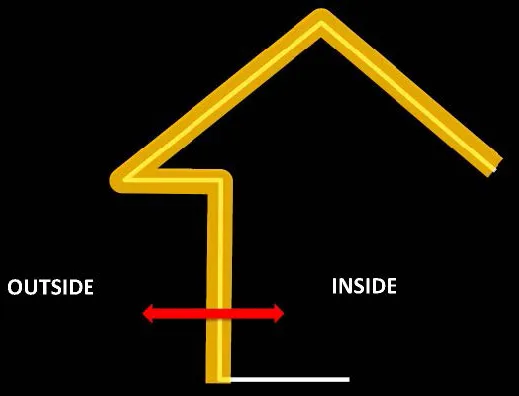
3) Identify the heat transfer process
- Building Heat Transfer Process

Building Heat Transfer
- Solar radiation incident on the building is at very high temperature and hence has short wavelength.
- Building surface heat up and radiate back the heat which is in the form of long wave radiation.
- Thus, short wave radiation enters the building and becomes long wave radiation.
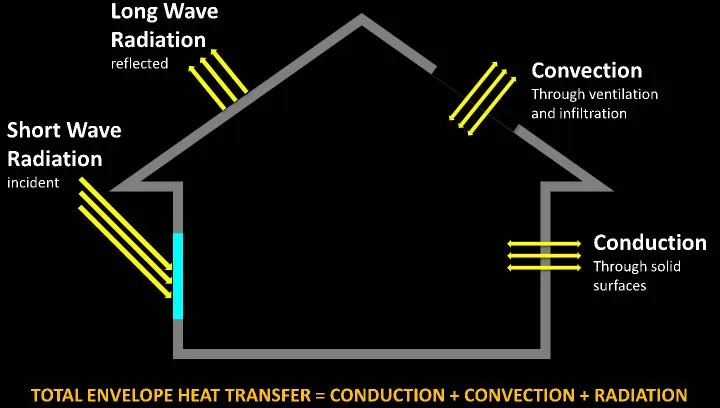
- What will be direction of heat flow?

- From higher temperature to lower temperature

- Assume, this is an exterior wall.
- What will be the mode of heat transfer ?

- Assume, this is an exterior wall.
- Conduction from warmer exterior surface to cooler interior surface.
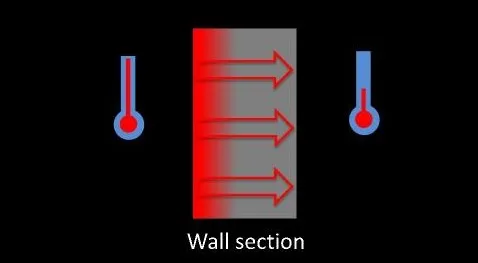
- Now this wall section has an air gap.
- What will be direction of heat flow in this case?
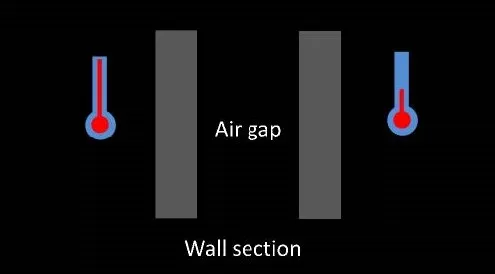
- Obviously, from higher temperature to lower temperature.

- How does heat gets transferred from the outer wall to the air gap and then to the inner wall?

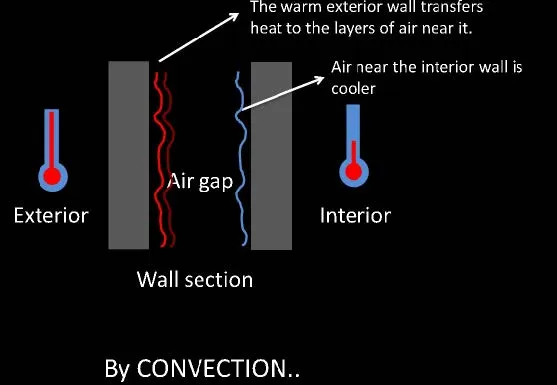
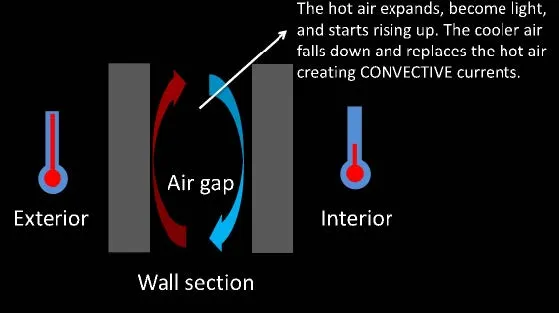
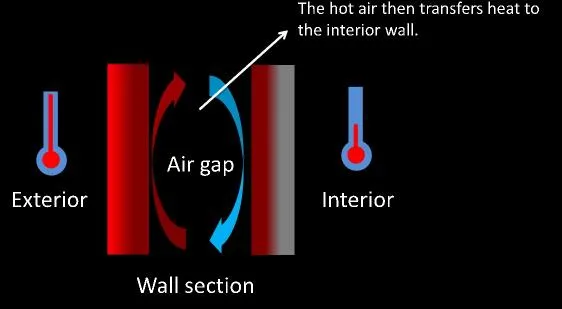
- Moreover, the exterior wall being at higher temperature will also start radiating heat in the cavity.
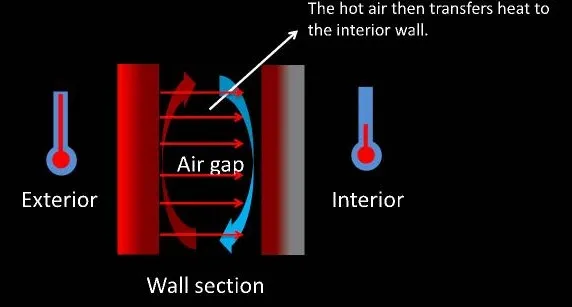
Now let’s look at an example with an added layer of material.

- How does the heat flow from exterior to interior?
- Try to sketch the different modes of heat transfer…

4) Heat exchange between building and external environment
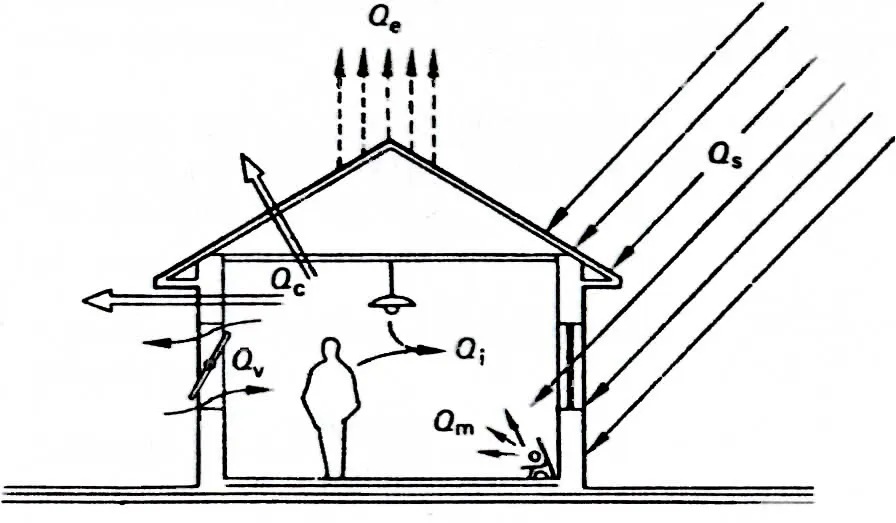
- The thermal balance, i.e., the existing thermal condition is maintained is comfortable if:
Qi+ Qs±Qc±Qv±Qm-Qe= 0
- The existing thermal condition maintained is COOLING if:
Qi+Qs±Qc±Qv±Qm-Qe=Negative
- The existing thermal condition maintained is HOT if:
Qi+Qs±Qc±Qv±Qm-Qe=Positive
Qi – Heat output from human bodies, lamps motors and appliances.
Qs- The effects of solar radiations on opaque surfaces (but through transparent surfaces window can be considered separately) can be included.
Qc- Conduction of wall may occur through the walls either inwards or outwards and is denoted by Qc
Qv- Heat exchange in either direction may take place with the movement of air i.e., ventilation.
Qm- There may be introduction or removal of heat (heating or cooling) using some form of outside energy supply. The heat flow of such mechanical controls may be denoted as Qm
Qe- If evaporation takes place on the surface of the building (e.g., roof pool) or within the building (human sweat or water in fountain) and vapors are removed, it produces a cooling effect.
5) Solar heat gain coefficient
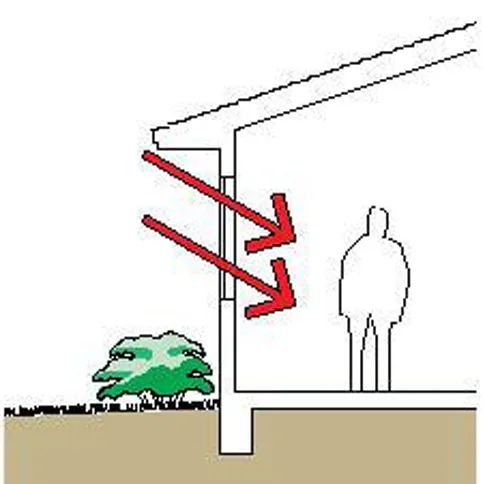
- The SHGC is the fraction of incident solar radiation admitted through a window.
- SHGC is expressed as a number between 0 and 1.
- The lower a window’s solar heat gain coefficient, the less solar heat gain coefficient, the less solar heat it transmits.
6) Sol-air temperature
- For building design purposes, it is useful to combine the heating effect of radiation incident on a building with the effect of warm air. This can be done by using the sol-air temperature concept.
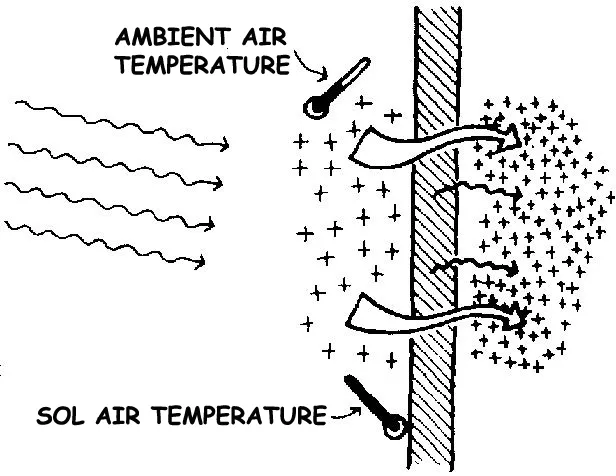
- The sol-air temperature is an imaginary temperature of a material. It is equivalent to the sum of the ambient air temperature, plus the calculated temperature effect of solar radiation incident on the outer surface.

Ts – Sol Air Temperature, in deg C.
To- Outside Air Temp, in deg C.
I – Radiation Intensity, in W/m2.
a- absorbance of the surface.
fo- Surface Conductance (outside), W/m2 deg C.
7) Thermal properties of a material
- Every material used in an envelope assembly has fundamental physical properties that determine their energy performance like conductivity, resistance, and thermal mass.
- Understanding these intrinsic properties will help you chose the right materials to manage heat flows.

8) Thermal conductivity (k)

- It is material’s ability to conduct heat.
- Each material has a characteristic rate at which heat will flow through it. The faster heat flows through a material, the more conductive it is.
- Conductivity (k) is a material property given for homogeneous solids under steady state conditions.

Where:
q = the resultant heat flow (Watts)
k = the thermal conductivity of the material (W/mK).
A = the surface area through which the heat flows (m²)
ΔT = the temperature difference between the warm
and cold sides of the material (K), and
L = the thickness / length of the material (m)
Units for conductivity SI-W/mºC or W/mK
9) Thermal conductance (C)
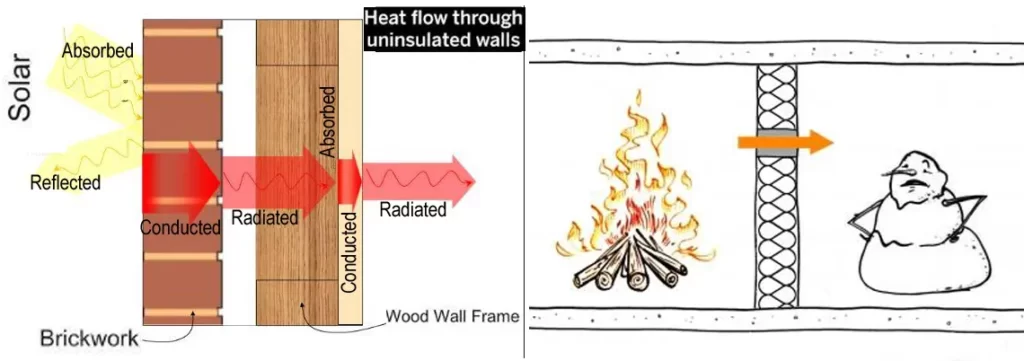
- Conductivity per unit area for a specified thickness. Used for standard building materials.
- Conductance is a material’s conductivity per unit area for the object’s thickness (in units of W/m² K for metric and BTU/hr • ft2 • °F for Imperial).
- Conductance is an object property and depends on both the material and its thickness.
- Many solid building materials such as common brick, wood siding, board insulation, and gypsum board are widely available in standard thicknesses and compositions.
- For such common materials, it is useful to know the rate of heat flow for that standard thickness instead of the rate per inch.
10) Thermal resistance (R value = 1/U)
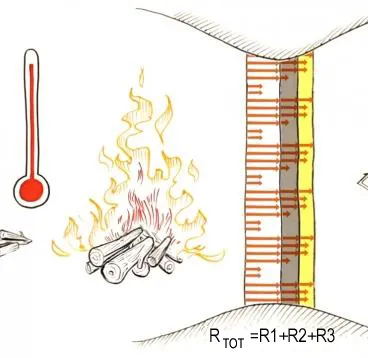
- A material’s ability to resis the at flow.
- Designated as R (R-value), thermal resistance indicates how effective any material is as an insulator.
- The reciprocal of thermal conductance, R is measured in hours needed for 1 Btu to flow through 1 ft2 of a given thickness of a material when the temperature difference is 1ºF.
- In the Imperial system, the units are ft2 • °F • hr / BTU. SI units are m² K/W.
- Insulation, which prevents heat flow through the building envelope, is often measured by its R-value.
- A higher R‐value indicates a better insulating performance.
11) Thermal lag (TIME LAG)

- With high thermal mass, it can take hours for heat to flow from one side of the envelope to the other.
- This slowing of the flow of heat is called “thermal lag”(or time lag) and is measured as the time difference between peak temperature on the outside surface of a building element and the peak temperature on the inside surface.
- The thermal lag can be as long as eight or nine hours for constructions with high thermal mass liked double-brick or rammed earth walls.
12) Psychrometric charts
What is Psychrometry?
- It is the science of studying air-vapor mixture
- We know that air can hold only certain amount of water vapor at a given temperature
Low temperature = Low levels of water vapor
High temperature = Low/High levels of water vapor
- However, we are only comfortable in only certain permutations – combinations of air temperature & humidity
Psychrometric charts show temperature vs. humidity, and can be used to express human thermal comfort, design strategies, and energy requirements for those strategies.
Psychometric Chart
- Dry-bulb temperature (DBT)
- Wet-bulb temperature (WBT)
- Relative humidity
- Dew point temperature
- Psychometric ratio

i) Dry-bulb temperature (DBT)
- It is the air temperature ordinarily measured with a thermometer
- Plotted on the horizontal axis Shown with vertical lines

ii) Wet-bulb temperature (WBT)
- It is used to infer the amount of water moisture in the air
- Represented by the diagonal lines on the chart

iii) Relative humidity
- Ratio of water vapor compared to the maximum amount air can hold
- Represented by the curved lines

iv) Dew point temperature
- The Dew Point is the temperature at which water vapor starts to condense out of the air
- Represented by the straight lines

Overall, understanding heat transfer in buildings is important for optimizing energy efficiency, reducing energy costs, and creating comfortable indoor environments.
i understood very =well
Simply explained. Intresting